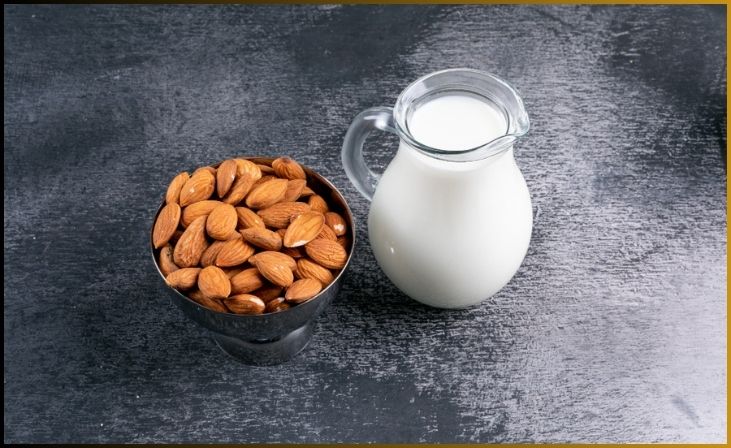Almond milk has long been a favorite dairy milk alternative for those seeking a plant-based lifestyle or navigating lactose intolerance. It’s a creamy, nutty, and versatile beverage that can be used in countless culinary creations. But did you know that you can take almond milk to the next level by turning it into cultured almond milk?
Cultured almond milk is not only a delicious treat but also a fantastic source of probiotics, those friendly microorganisms known for their digestive and overall health benefits. In this blog, we’ll explore the art of crafting your very own cultured almond milk, step by step. We’ll also delve into the significance of probiotics, the health benefits of this delightful concoction, and some exciting ways to use it in your daily culinary adventures.
Table of Contents
ToggleHealth Benefits of Cultured Almond Milk

Cultured almond milk is more than just a tasty alternative to dairy milk; it’s a nutritional powerhouse with a multitude of health benefits. Here are five significant advantages of incorporating cultured almond milk into your diet:
1. Probiotic Support for Gut Health: Cultured almond milk is teeming with live probiotics, which are beneficial microorganisms known for their positive impact on gut health. These probiotics help maintain a balanced gut microbiome, supporting digestion and nutrient absorption. A healthy gut is crucial for overall well-being, from improved digestion to enhanced immunity and even potential mood benefits.
For More- Quick Probiotic Banana Pudding Cups
2. Dairy-Free and Lactose-Free: One of the primary reasons people turn to almond milk is its dairy-free nature. Cultured almond milk provides a lactose-free alternative to dairy products, making it an excellent choice for individuals with lactose intolerance. It’s a creamy and satisfying option for those who are lactose intolerant, yet still crave the taste and texture of traditional dairy products.
3. Nutrient-Rich Profile: Cultured almond milk is packed with essential nutrients, making it a valuable addition to your diet. Almonds are rich in vitamins, such as vitamin E and B vitamins, and minerals like calcium and magnesium. Additionally, almond milk is often fortified with nutrients like vitamin D and calcium, further boosting its nutritional value.
4. Bone Health Support: Many fortified versions of almond milk contain essential nutrients like calcium and vitamin D. These nutrients are vital for maintaining strong bones and teeth. By consuming cultured almond milk, you’re actively contributing to your bone health, which is essential for individuals of all ages, from growing children to aging adults.
5. Versatility in Culinary Applications: Cultured almond milk’s unique tangy flavor and creamy texture make it a versatile ingredient in the kitchen. You can use it as a base for smoothies, coffee, and tea, or incorporate it into baking and dessert recipes. It adds a depth of flavor and creaminess to both sweet and savory dishes, making it a valuable addition to your culinary repertoire.
Crafting Your Cultured Almond Milk
Ingredients:
- 1 cup raw almonds (soaked overnight)
- 4 cups filtered water
- 1-2 tablespoons sweetener (such as honey or maple syrup)
- 1 probiotic capsule or a starter culture
- A pinch of salt
- Optional flavorings: vanilla extract, cocoa powder, or fruit puree
Instructions:
1. Soak the Almonds
To begin making cultured almond milk, start by soaking raw almonds in water. Soaking softens the almonds, making them easier to blend and extract the creamy milk. This step also aids in removing any enzyme inhibitors, enhancing the overall digestibility of the almonds. Allow the almonds to soak overnight or for at least 8 hours for the best results. Once soaked, they’ll be ready for the next steps in creating your delicious and probiotic-rich almond milk.
2. Rinse and Blend
After soaking the almonds, the next step is to rinse and blend them. Start by draining the soaked almonds and giving them a thorough rinse. This rinsing process removes any residual enzyme inhibitors and ensures your cultured almond milk will have a clean, pure flavor. Once rinsed, transfer the almonds to a blender and add filtered water. Blend until the mixture becomes smooth and creamy, creating the base for your almond milk. This step is essential to extract the almond essence and prepare it for the following culturing process.
Don't just scroll, subscribe!
BuzzTrail's unique web-stories are the cure for boredom you've been waiting for.
3. Strain the Milk
Following the blending step, it’s time to strain the almond milk. Straining helps separate the liquid from the almond pulp, giving you a smooth, creamy result. To do this, use a nut milk bag, fine cheesecloth, or a strainer. Pour the blended almond mixture through the chosen straining tool, then squeeze or press it to extract as much liquid as possible. What remains in the strainer is the almond pulp, while the strained liquid is your almond milk base. This step ensures your almond milk is free from any grittiness or unwanted textures, leaving you with a silky, pure liquid for culturing and flavoring.
4. Sweeten and Flavor
Once you’ve strained the almond milk, the next step is to sweeten and add flavor. Return the strained almond milk to the blender and add your choice of sweetener, such as honey or maple syrup, according to your taste preferences. A pinch of salt can also be added to enhance the overall flavor. Additionally, you can include optional flavorings like vanilla extract, cocoa powder, or fruit puree to create a unique taste profile. Blend these additions into the almond milk until well combined, customizing your cultured almond milk to suit your desired sweetness and flavor, making it even more enjoyable.
5. Introduce Probiotics
After sweetening and flavoring your almond milk, it’s time to introduce probiotics. Open a probiotic capsule and empty its contents into the almond milk. Alternatively, you can use a starter culture following the package instructions. The addition of probiotics is a crucial step in culturing the almond milk, as these live microorganisms will ferment and enhance the milk’s gut-friendly properties. This fermentation process introduces the tangy and probiotic-rich qualities that set cultured almond milk apart from regular almond milk, elevating both its flavor and health benefits.
6. Ferment
After adding probiotics to the almond milk, the next step is to let it ferment. Transfer the almond milk mixture to a clean, glass container with an airtight lid. Leave it at room temperature for a period of 12 to 24 hours. The longer you allow it to ferment, the tangier the cultured almond milk will become. During this fermentation process, the probiotics actively multiply and release beneficial compounds, creating a distinctive flavor profile and increasing its gut-friendly properties. This fermentation step is what makes your almond milk “cultured,” imbuing it with unique taste and health benefits.
7. Refrigerate
After the fermentation period, it’s essential to refrigerate your cultured almond milk. This step is crucial to slow down the fermentation process and maintain the flavor and texture you desire. Refrigeration not only helps preserve the probiotics but also ensures that your almond milk remains fresh and safe for consumption. You can enjoy your probiotic-rich and tangy almond milk at any time by keeping it in the fridge. Refrigerated, it can last for several days, allowing you to savor its delicious and gut-friendly qualities whenever you desire.
Why Cultured Almond Milk?

Cultured almond milk takes the classic nut milk to a whole new level. Here’s why it’s worth trying:
- Probiotic Goodness: The fermentation process introduces live probiotics into your almond milk, enhancing its gut-friendly properties.
- Enhanced Flavor: Culturing adds a delightful tanginess to almond milk, making it more exciting and versatile for various culinary applications.
- Digestive Health: By incorporating probiotics, you’re actively contributing to your digestive well-being with every sip.
- Homemade Goodness: Making your own cultured almond milk ensures that you control the ingredients and avoid additives or preservatives commonly found in store-bought versions.
How to Use Cultured Almond Milk
Cultured almond milk can be enjoyed in various ways:
- As a Beverage: Sip it as is, blend it into smoothies, or use it in your morning cereal.
- In Smoothie Bowls: Add creaminess and a probiotic punch to your favorite smoothie bowls.
- In Coffee or Tea: Swap out regular milk for cultured almond milk in your daily brew.
- In Baking: Use it in recipes that call for milk, adding a unique depth of flavor to your baked goods.
- In Desserts: Make probiotic-rich puddings, parfaits, or ice creams.
- As a Savory Ingredient: Incorporate it into soups, sauces, or salad dressings for a tangy twist.
Also Read- Scrumptious Blintzes For Brunch: A Morning Delight
Final Words
In your journey to culinary creativity and well-being, crafting your own cultured almond milk stands as a delightful and health-conscious choice. It’s more than just a tasty dairy milk alternative; it’s a homemade probiotic-rich powerhouse. The steps are simple, and the results are extraordinary. From gut health support to lactose-free goodness and a rich nutrient profile, cultured almond milk has it all.
With every sip or use in your culinary creations, you’re embracing a proactive approach to your health and indulging in a creamy, tangy delight. Whether you enjoy it as a beverage, in your morning coffee, or as an ingredient in your favorite recipes, cultured almond milk offers an exceptional depth of flavor and a boost to your well-being.
FAQs
What are probiotics, and why are they important in cultured almond milk?
What are probiotics, and why are they important in cultured almond milk?
Probiotics are live microorganisms that support gut health and overall well-being. In cultured almond milk, they contribute to its tangy flavor and offer digestive benefits.
Is homemade cultured almond milk better than store-bought options?
Is homemade cultured almond milk better than store-bought options?
Homemade cultured almond milk allows you to control the ingredients and avoid additives, providing a purer and fresher option.
Can I use different sweeteners and flavorings in my almond milk?
Can I use different sweeteners and flavorings in my almond milk?
Yes, you can customize the sweeteners and flavorings to your preference, creating a unique almond milk flavor.
How long can I store cultured almond milk in the refrigerator?
How long can I store cultured almond milk in the refrigerator?
Refrigerated, cultured almond milk can last for several days, depending on factors like temperature and cleanliness. It’s best to consume it within a few days to enjoy its optimal taste and benefits.

